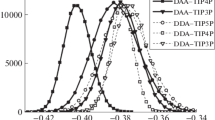Abstract
The dynamics of a system containing 3456 water molecules in a cubic cell with periodic boundary conditions at 297 K was simulated. The time dependence of distances between oxygen atoms was examined for many pairs of molecules. These distances often oscillate around a certain average value over long periods of time (10 ps and longer). These average values can be about 2.8 Å (hydrogen bond) or much larger, up to 12–13 Å and more. This suggests that big groups of molecules are involved in a concerted motion. Lists of hydrogen bonds in 50 configurations divided by an interval of about 1 ps are compared. The average lifetime of a hydrogen bond is about 7 ps. The network of hydrogen bonds is colored according to their lifetimes for one of the configurations. The bonds that live longer than 7 ps form an infinite cluster. The bonds that live longer than 8 ps join to form a great number of finite clusters including several hundreds of nodes (molecules). These clusters contain few closed cycles. Even the bonds that live longer than 20 ps are united into clusters each containing two or three nodes (molecules). The self-diffusion coefficient for molecules involved in long-lived bonds is likely to be slightly smaller than that for molecules which do not participate in these bonds.
Similar content being viewed by others
References
M. Holz, S. R. Heil, and A. Sacco, Phys. Chem. Chem. Phys., 2, 4740–4742 (2000).
M. Bée, Quasielastic Neutron Scattering. Principles and Applications in Solid State Chemistry, Biology and Material Science, Adam Higler, Bristol, Philadelphia (1988).
Ya. I. Frenkel, Kinetic Theory of Liquids [in Russian], Nauka, Leningrad (1975).
V. S. Oskotskii, Fiz. Tverd. Tela, 5, No. 4, 1082–1085 (1963).
L. A. Bulavin, N. P. Malomuzh, and K. N. Pankratov, J. Struct. Chem., 47, No. 1, 48–55 (2006).
L. A. Bulavin, N. P. Malomuzh, and K. N. Pankratov. ibid., Supplement, S50–S60.
A. G. Novikov, M. N. Rodnikova, V. V. Savostin, and O. V. Sobolev, Zh. Fiz. Khim., 68, No. 11, 1982–1986 (1994).
I. S. Andrianova, O. Ya. Samoilov, and I. Z. Fisher, Zh. Strukt. Khim., 8, No. 5, 813–816 (1967).
J. Teixeira, M. C. Bellissent-Funel, S. H. Chen, and A. J. Dianoux, Phys. Rev., A31, 1913–1920 (1985).
I. Z. Fisher, Zh. Éksp. Teor. Fiz., 61, No. 4, 1647–1659 (1971).
T. V. Lokotosh and N. P. Malomuzh, Physica, 286A, Nos. 3/4, 474–488 (2000).
C. Branca, A. Faraone, T. Lokotosh, et al., J. Mol. Liq., 93, Nos. 1–3, 139–149 (2001).
L. A. Bulavin, T. V. Lokotosh, N. P. Malomuzh, and K. S. Shakun, Ukr. Phys. J., 49, No. 6, 557–562 (2004).
I. Ohmine, H. Tanaka, and P. G. Wolynes, J. Chem. Phys., 89, No. 9, 5852–5860 (1988).
D. Bertolini, A. Tani, and R. Vallauri, Mol. Phys., 73, No. 1, 69–78 (1991).
V. I. Poltev, T. A. Grokhlina, and G. G. Malenkov, J. Biomolec. Struct. Dynam., 2, No. 2, 421–429 (1984).
V. P. Voloshin, E. A. Zheligovskaya, G. G. Malenkov, et al., Ros. Khim. Zh. (Zh. Ros. Khim. O-va Mendeleeva), 45, No. 3, 31–37 (2001).
J. S. Kasper and S. M. Richards, Acta Crystallogr., 17, 152–755 (1964).
G. G. Malenkov, M. M. Frank-Kamenetskii, and A. G. Grivtsov, Zh. Strukt. Khim., 28, No. 2, 81–85 (1987).
G. G. Malenkov and D. L. Tytik, Molecular Dynamic Method in Physical Chemistry [in Russian], Yu. K. Tovbin (ed.), Nauka, Moscow (1996), pp. 204–233 (see also pp. 85–87).
G. G. Malenkov and D. L. Tytik, Izv. Ross. Akad. Nauk, Ser. Fiz., 64, No. 8, 1469–1474 (2000).
G. G. Malenkov, J. Struct. Chem., 47, Supplement, S1–S31 (2006).
Author information
Authors and Affiliations
Corresponding author
Additional information
Original Russian Text Copyright © 2007 by V. P. Voloshin, G. G. Malenkov, and Yu. I. Naberukhin
__________
Translated from Zhurnal Strukturnoi Khimii, Vol. 48, No. 6, pp. 1133–1138, November–December, 2007.
Rights and permissions
About this article
Cite this article
Voloshin, V.P., Malenkov, G.G. & Naberukhin, Y.I. Description of collective effects in computer models of water. J Struct Chem 48, 1066–1072 (2007). https://doi.org/10.1007/s10947-007-0172-z
Received:
Issue Date:
DOI: https://doi.org/10.1007/s10947-007-0172-z



